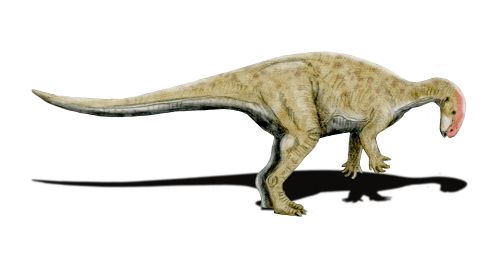Cumnoria Prestwichii on:
[Wikipedia]
[Google]
[Amazon]
''Cumnoria'' is a

genus
Genus ( plural genera ) is a taxonomic rank used in the biological classification of extant taxon, living and fossil organisms as well as Virus classification#ICTV classification, viruses. In the hierarchy of biological classification, genus com ...
of herbivorous iguanodontian dinosaur
Dinosaurs are a diverse group of reptiles of the clade Dinosauria. They first appeared during the Triassic period, between 243 and 233.23 million years ago (mya), although the exact origin and timing of the evolution of dinosaurs is t ...
. It was a basal iguanodontian that lived during the Late Jurassic period ( Kimmeridgian age) in what is now Oxfordshire
Oxfordshire is a ceremonial and non-metropolitan county in the north west of South East England. It is a mainly rural county, with its largest settlement being the city of Oxford. The county is a centre of research and development, primarily ...
, United Kingdom
The United Kingdom of Great Britain and Northern Ireland, commonly known as the United Kingdom (UK) or Britain, is a country in Europe, off the north-western coast of the continental mainland. It comprises England, Scotland, Wales and North ...
.
Description
The holotype of ''Cumnoria'' is of a rather small bipedal animal with a slender build. about 3.5 metres (11.4 feet) long, The specimen is probably that of a juvenile though.
History of discovery
''Cumnoria'' is known from theholotype
A holotype is a single physical example (or illustration) of an organism, known to have been used when the species (or lower-ranked taxon) was formally described. It is either the single such physical example (or illustration) or one of several ...
OXFUM J.3303, a partial skull
The skull is a bone protective cavity for the brain. The skull is composed of four types of bone i.e., cranial bones, facial bones, ear ossicles and hyoid bone. However two parts are more prominent: the cranium and the mandible. In humans, the ...
and postcranium Postcrania (postcranium, adjective: postcranial) in zoology and vertebrate paleontology is all or part of the skeleton apart from the skull. Frequently, fossil remains, e.g. of dinosaurs or other extinct tetrapods, consist of partial or isolated sk ...
, recovered from the lower Kimmeridge Clay Formation, in the Chawley Brick Pits, Cumnor Hurst
Hurst Hill or Cumnor Hurst is a biological and geological Site of Special Scientific Interest west of Oxford in Oxfordshire. It is a Geological Conservation Review site.
The site is owned by All Souls College, Oxford, and its mosses and liverw ...
. Workers at first discarded the remains on a dump heap, but one of them later collected the bones in a sack and showed them to Professor George Rolleston
George Rolleston MA MD FRCP FRS (30 July 1829 – 16 June 1881) was an English physician and zoologist. He was the first Linacre Professor of Anatomy and Physiology to be appointed at the University of Oxford, a post he held from 1860 until ...
, an anatomist at the nearby Oxford University
Oxford () is a city in England. It is the county town and only city of Oxfordshire. In 2020, its population was estimated at 151,584. It is north-west of London, south-east of Birmingham and north-east of Bristol. The city is home to the ...
. Rolleston in turn brought them to the attention of palaeontologist Professor Joseph Prestwich who in 1879 reported them as a new species of ''Iguanodon'', though without actually coining a species name. In 1880 Prestwich published an article on the geological stratigraphy
Stratigraphy is a branch of geology concerned with the study of rock (geology), rock layers (Stratum, strata) and layering (stratification). It is primarily used in the study of sedimentary rock, sedimentary and layered volcanic rocks.
Stratigrap ...
of the find. The same year John Whitaker Hulke named the species ''Iguanodon prestwichii'', the specific epithet
In taxonomy, binomial nomenclature ("two-term naming system"), also called nomenclature ("two-name naming system") or binary nomenclature, is a formal system of naming species of living things by giving each a name composed of two parts, bot ...
honouring Prestwich.
In 1888
In Germany, 1888 is known as the Year of the Three Emperors. Currently, it is the year that, when written in Roman numerals, has the most digits (13). The next year that also has 13 digits is the year 2388. The record will be surpassed as late ...
, Harry Govier Seeley decided the taxon represented a new and separate genus which he named ''Cumnoria'' after Cumnor, the village where it was discovered. Its type species
In zoological nomenclature, a type species (''species typica'') is the species name with which the name of a genus or subgenus is considered to be permanently taxonomically associated, i.e., the species that contains the biological type specimen ...
''Iguanodon prestwichii'' was thus recombined into ''Cumnoria prestwichii'' — though Seeley spelled the epithet as ''prestwichi''. The genus was quickly abandoned however: already in 1889 Richard Lydekker
Richard Lydekker (; 25 July 1849 – 16 April 1915) was an English naturalist, geologist and writer of numerous books on natural history.
Biography
Richard Lydekker was born at Tavistock Square in London. His father was Gerard Wolfe Lydekker, ...
assigned the species to ''Camptosaurus'', as ''Camptosaurus prestwichii''. This opinion was generally accepted for over a century. In 1980 Peter Galton provided the first modern description of the species.
In 1998 David Norman concluded that Seeley's original generic distinction was valid. In 2008 this was supported by Darren Naish and David Martill
{{Short pages monitor